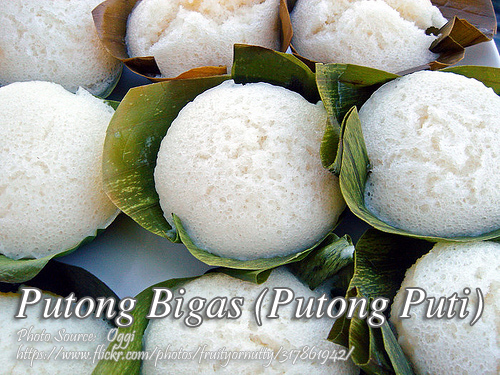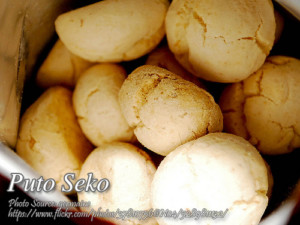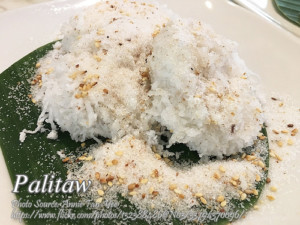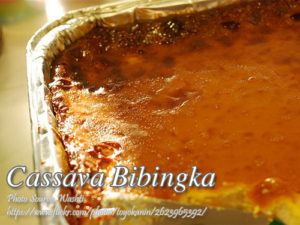This recipe is steamed puto made from ground ordinary rice instead of the usual flour. There are many varieties of rice used in cooking. Don’t use the glutinous rice which is the variety usually used in cooking kakanin or other native delicacies like suman. Use only ordinary rice. Gone are the days that you can only grind the rice with the old fashion stone grinder. If you have a blender, you can grind almost anything including the soaked rice to make the putong bigas.
Delicious Putong Bigas Recipe
Putong Bigas, also known as Putong Puti, is a delightful Filipino steamed rice cake that stands out from the rest. Instead of the usual flour, this recipe uses ground ordinary rice, making it a unique and delightful treat. In this recipe blog post, we’ll guide you through the steps to create this mouthwatering dish that’s perfect for any occasion.
Choosing the Right Rice
Before we dive into the recipe, it’s essential to select the right type of rice. While there are numerous rice varieties available, avoid using glutinous rice commonly used in making kakanin or suman. For Putong Bigas, stick to ordinary rice. Gone are the days when you had to rely on old-fashioned stone grinders. If you have a blender, you can easily grind the soaked rice to perfection.
Soaking the Rice
Start by soaking the rice overnight in 3 cups of water. This step allows the rice to absorb moisture, making it easier to grind later on. Once soaked, drain the rice using a strainer.
Blending the Rice
Now, it’s time to transform your soaked rice into a thick batter. Place the soaked rice in a blender and add 1 cup of water from the soaked rice. Blend until you achieve the desired consistency.
Sweetening the Batter
In a mixing bowl, transfer the ground rice and add sugar. Mix thoroughly until the sugar completely dissolves into the batter. This step adds a delightful sweetness to the Putong Bigas.
Adding the Magic Touch
To give your Putong Bigas its signature fluffy texture, add baking powder to the batter. Mix gently until the baking powder is fully dissolved and well combined with the batter. Be cautious not to overmix; the key is achieving the perfect balance.
Perfecting the Consistency
It’s crucial to maintain the right batter consistency. If it’s too thick, your Putong Bigas may become hard, resembling cuchinta. On the other hand, if it’s too thin, the result might be soggy. Adjust the consistency by adding more water if necessary.
The Waiting Game
Cover your mixing bowl with cling wrap or wax paper and allow the batter to ferment. This waiting period is essential for the baking powder to react with the batter, enhancing its flavor and texture. Give it approximately 4 hours for this magical transformation.
Stirring It Up
After the four-hour fermentation period, gently stir the batter. To make it easier to pour into molds, transfer the batter to a pitcher.
Prepping the Molds
Traditionally, Putong Bigas is cooked in molds lined with banana leaves. However, if banana leaves are not available, you can grease the molds with cooking oil or butter. This step ensures that your Putong Bigas won’t stick to the molds.
Steam Time
Now it’s time to cook your Putong Bigas to perfection. Fill the molds with the batter, filling them approximately 2/3 full. To prevent water from the steam from dripping onto your Putong Bigas, wrap the lid of the steamer with a piece of cloth.
The Steamy Finale
Arrange your filled molds in a steamer and let them steam for about 30 minutes. You’ll know they’re ready when a toothpick inserted into the center of a puto comes out dry.
Enjoy Your Homemade Putong Bigas
Congratulations, you’ve successfully made your very own Putong Bigas or Putong Puti! This Filipino rice cake is a delightful blend of flavors and textures, making it a favorite treat for both young and old. Serve it as a snack or dessert, and watch as your loved ones savor every bite.
Putong Bigas is a versatile dish that can be enjoyed on various occasions. Whether you’re celebrating a special event or simply craving a sweet and satisfying snack, this recipe is sure to hit the spot.
Wrapping-Up
Making Putong Bigas is a delightful culinary adventure that showcases the rich flavors and traditions of Filipino cuisine. With the right ingredients and a little patience, you can recreate this beloved dish in the comfort of your own kitchen. So, gather your ingredients, follow the steps, and treat yourself and your loved ones to a batch of homemade Putong Bigas today. It’s a truly unforgettable taste of Filipino culture that you won’t want to miss.
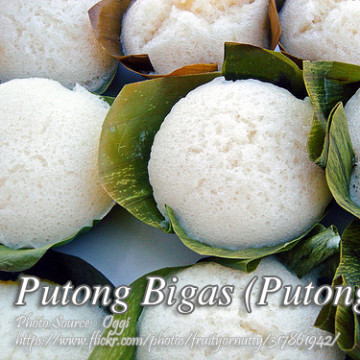
How to Make Putong Bigas or Putong Puti
Ingredients
- 2 cups ordinary rice uncooked
- 3 cups tap water for soaking the rice
- 1 cup water from the soaked rice (add more water if the batter is too thick)
- 3/4 cup white sugar
- 1 Tbsp. baking powder
- banana leaves optional
Instructions
How to Make Putong Bigas or Putong Puti
- Soak rice overnight in 3 cups water. Drain the rice using a strainer then put in a blender and add 1 cup of water from the soaked rice and grind to consistency of thick batter.
- After you finish grinding the rice, transfer to a mixing bowl then add sugar and mix until the sugar is completely dissolved.
- Then add in the baking powder and mix until the baking powder is dissolved and well combined with the batter. Do not over mix!
- Please take note that the consistency should not be too thick or it will become hard like cuchincta nor too thin, which will make the puto soggy. Add more water if it is too thick.
- Then cover with cling wrap or wax paper and wait for it to ferment or for the baking powder to react on the batter for 4 hours.
- After four hours, stir the batter gently. Transfer to a pitcher so you can easily pour on the puto molds.
- Line the molds with banana leaves then pour the batter 2/3 full. Or you can just grease the molds with cooking oil or butter if there are no banana leaves available.
- Wrap the lid with a piece of cloth so the water from the steam will not drip on the puto.
- Arrange in steamer and steam 30 minutes or if toothpick inserted in center of puto comes out dry.
Notes
Cooking Tips for Perfect Putong Bigas (Putong Puti)
Making Putong Bigas is a delightful culinary experience, but to ensure your rice cakes turn out perfectly, consider these three essential cooking tips: 1. Achieve the Right Batter Consistency: The consistency of your batter is crucial in determining the texture of your Putong Bigas. It should be neither too thick nor too thin. A batter that's too thick can result in hard and dry rice cakes, while a batter that's too thin may make your Putong Bigas soggy. To get it just right, adjust the consistency by adding more water if needed. Aim for a batter that flows smoothly but isn't overly runny. 2. Proper Steaming Time: Steaming time plays a significant role in achieving the perfect texture for your Putong Bigas. The suggested steaming time of 30 minutes is a general guideline, but it may vary depending on factors like the size of your molds and the intensity of your steamer. To check for doneness, insert a toothpick into the center of a puto. If it comes out dry, your rice cakes are ready. Be cautious not to overcook, as this can result in dry and crumbly Putong Bigas. 3. Banana Leaves or Greased Molds: Traditionally, Putong Bigas is cooked in molds lined with banana leaves, which impart a subtle, aromatic flavor to the rice cakes. However, if banana leaves are not readily available, you can grease the molds with cooking oil or butter. Ensure a thorough coating to prevent sticking. This step not only enhances the release of the rice cakes but also adds a touch of richness to the flavor.
